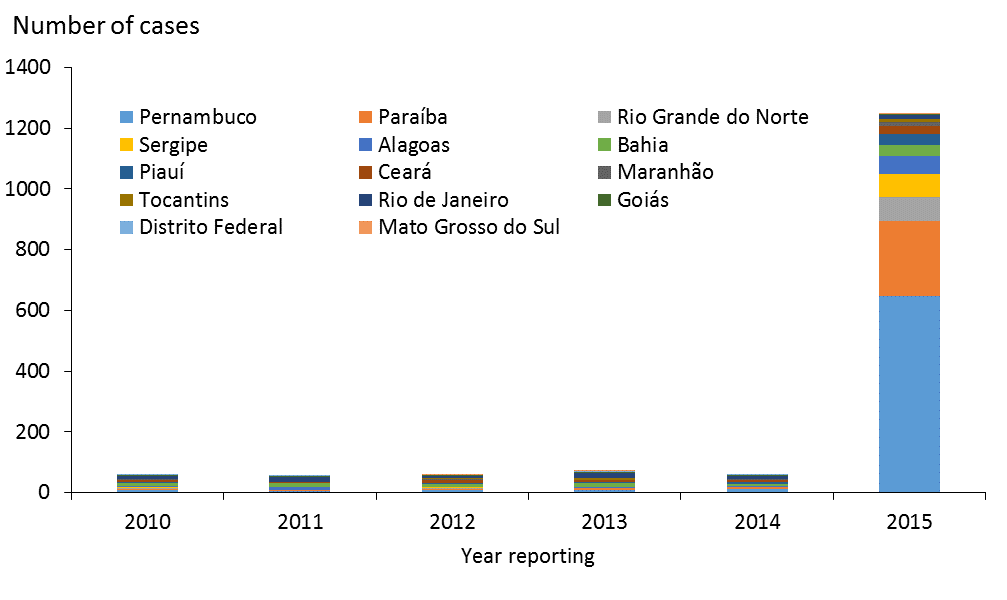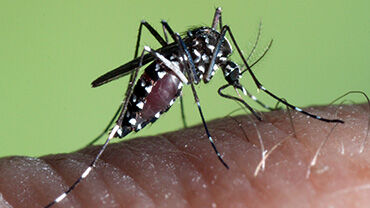Epidemiological update: Evolution of the Zika virus global outbreaks and complications potentially linked to the Zika virus outbreaks
Outbreaks of Zika virus are evolving around the world, and complications potentially linked to the outbreaks become clearer.

On 1 December 2015, the Pan American Health Organization/World Health Organization issued an epidemiological alert entitled ‘Neurological syndrome, congenital malformations and Zika virus (ZIKV) infection. Implications for public health in the Americas’. The alert states: ‘Given the increase of congenital anomalies, Guillain-Barré syndrome, and other neurological and autoimmune syndromes in areas where Zika virus is circulating and their possible relation to the virus, the Pan American Health Organization/World Health Organization (PAHO/WHO) recommends its Member States to establish and maintain the capacity to detect and confirm Zika virus cases, prepare healthcare facilities for the possible increase in demand at all healthcare levels and specialized care for neurological syndromes, and to strengthen antenatal care. In addition, Member States should continue efforts to reduce the presence of mosquito vectors through an effective vector control strategy and public communication’. The alert also states: ‘According to the preliminary analysis of the investigation conducted by the Brazilian health authorities, the greatest risk of microcephaly or congenital anomalies in new-borns is associated with Zika virus infection in the first trimester of pregnancy’.
Epidemiological summary
Europe
No autochthonous cases of Zika virus (ZIKV) infection have been reported in EU Member States so far in 2015.
Americas
BrazilIn May 2015, the public health authorities of Brazil confirmed autochthonous transmission of ZIKV infection in the north-eastern part of the country. As of 8 October 2015, autochthonous virus transmission had been confirmed in 14 states: Alagoas, Bahia, Ceará, Maranhão, Mato Grosso, Pará, Paraíba, Paraná, Pernambuco, Piauí, Rio de Janeiro, Rio Grande do Norte, Roraima and São Paulo. In addition, between January and July 2015, 121 cases with neurological symptoms or with Guillain-Barré were reported by states in the north-eastern part of Brazil.In October 2015, the Ministry of Health of Brazil reported an unusual increase in cases of microcephaly in the state of Pernambuco and at a lower level in other north-eastern states. On 17 November 2015, the Ministry of Health of Brazil confirmed in an international health regulation (IHR) message the molecular identification of ZIKV in amniotic fluid samples collected from two pregnant women in Paraiba state whose foetuses had been confirmed with microcephaly by ultrasound examinations.On 17 November 2015, the Pan American Health Organization (PAHO) issued an epidemiological alert regarding an increase in microcephaly in the north-east of Brazil. In response to the situation, Brazil’s Ministry of Health had declared a national public health emergency on 11 November 2015. As of 28 November 2015, 1 248 suspected cases of microcephaly have been identified in 311 municipalities across 14 states of Brazil. Pernambuco state has reported the highest number of cases (646) followed by the states of Paraíba (248), Rio Grande do Norte (79), Sergipe (77), Alagoas (59), Bahia (37), Piauí (36), Ceará (25), Rio de Janeiro (13), Maranhão (12), Tocantins (12), Goiás (2), Distrito Federal (1) and Mato Grosso do Sul (1). Seven deaths were reported among these cases, and five additional deaths in Rio Grande do Norte and Piauí are currently being investigated.As of 1 December 2015, according to media quoting the Ministry of Health, 28 cases of Guillain–Barré syndrome (GBS) had been reported in Sergipe state. Last week, according to media, seven cases of Guillain–Barré syndrome (GBS) were linked to ZIKV infections in Pernambuco state.On 25 November 2015, according to media quoting the Flavivirus Laboratory at the Oswaldo Cruz Institute, seven cases of Guillain–Barré syndrome (GBS) had been linked to ZIKV infections in Pernambuco state. The number of cases of GBS grew significantly in the north-east of the country between April and June 2015, shortly after the ZIKV epidemic started. In Rio Grande do Norte, there have been 24 cases of GBS, four times more than the historical average. In Pernambuco state, 130 cases have been reported, which is a significant increase on the most recent reports. There have also been increases in the states of Maranhão (14 cases) and Paraíba (six cases). Investigations are ongoing regarding a possible association with ZIKV infection.
Figure 2. Notified cases of microcephaly in Brazil, 2010–2014 and 2015 for 14 states (under investigation)

Chile (Easter Island)According to WHO-PAHO, autochthonous circulation of ZIKV was reported in Easter Island from February to June 2014. Chile did not report any cases of ZIKV in 2015.ColombiaOn 16 October 2015, the first cases of ZIKV infections were reported in Colombia, with nine confirmed cases in the Bolívar department. From 16 October to 21 November, Colombian authorities reported 578 confirmed cases and 2 635 suspected cases. El SalvadorOn 24 November 2015, the El Salvador IHR National Focal Point (NFP) gave notification of three confirmed autochthonous cases of ZIKV infection. On 3 December, media reported 240 ZIKV cases across the country.GuatemalaOn 1 December 2015, media, quoting authorities, reported 17 suspected cases of ZIKV infection, 14 of which were among hospital employees. Blood samples have been collected and sent to the US for analysis.MexicoOn 26 November 2015, authorities acknowledged three ZIKV cases, including two autochthonous cases reported from Nuevo León and Chiapas. The imported cases had recently travelled to Colombia.PanamaOn 3 December 2015, the Ministry of Health of Panama reported three autochthonous cases of Zika virus infection. All three cases are residents of the district of Ailigandi, Guna Yala (north-east).ParaguayOn 27 November 2015, the Paraguay IHR National Focal Point (NFP) reported the confirmation of six ZIKV cases in the city of Pedro Caballero – close to the border with Brazil.SurinameOn 12 November 2015, the authorities reported five cases of ZIKV through IHR.VenezuelaOn 27 November 2015, the Venezuela IHR National Focal Point (NFP) gave notification of seven ZIKV autochthonous suspected cases.
Pacific region
French PolynesiaOn 24 November 2015, the health authorities of French Polynesia reported an unusual increase of at least 17 cases of central nervous system malformations in foetuses and infants during 2014–2015. The cases are reported from pregnancies that occurred during the ZIKV infection outbreak in French Polynesia (September 2013 to March 2014) at a gestational age of less than six months. None of the pregnant women described clinical signs of ZIKV infection, but the four tested were found positive by IgG serology assays for flavivirus, suggesting a possible asymptomatic ZIKV infection. Further serological investigations are ongoing. Based on the temporal correlation of these cases with the ZIKV epidemic, the health authorities of French Polynesia hypothesise that ZIKV infection may be associated with these abnormalities if mothers are infected during the first or second trimester of pregnancy.Other countriesSince the beginning of the year, sporadic autochthonous cases have been reported in Samoa, Fiji, New Caledonia, the Solomon Islands, Vanuatu and New Zealand (two imported cases from Samoa).
Asia
IndonesiaOn 15 November 2015, media reported the first ZIKV case in the country. There was no information available about the travel history of this case.
Africa
Cape VerdeOn 3 November 2015, the Cape Verde Ministry of Health reported that 17 out of 64 blood samples sent for confirmation at the Pasteur Institute in Dakar were positive for ZIKV and there were approximately 1 000 suspected cases showing symptoms consistent with ZIKV infection as of 1 November 2015.







